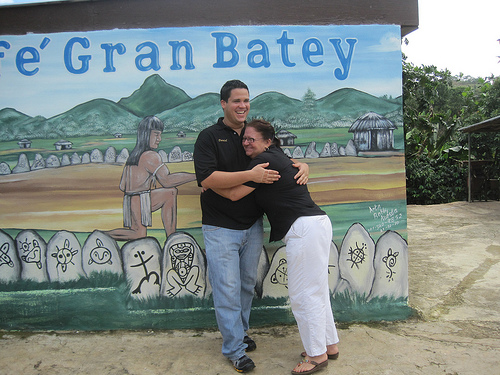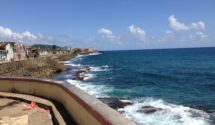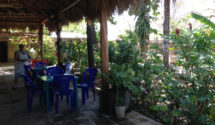
Culturally sustainable tourism
I want to give a little attention to the idea of culturally sustainable tourism.
Tourism can be culturally destructive. We all know what a tourist trap feels like – an area that’s adapted itself to tourists so much, the original culture no longer dominates. A tour director friend describes it as, “genetically modified to appeal to tourists.”

Daniel, Lotty and the rest of the family run a tiny coffee farm in interior Puerto Rico. No hordes of tourists here! Just the occasional tiny group of visitors like us.
Generally, you see cultural destruction on a grand scale, when an area’s businesses all cater to tourists. But it can happen in little ways, too. Sometimes just the presence of tourists crowds out the local culture – depending on the tourists. If you take a really loud group to a quiet place, guess what? It’s no longer a quiet place. And if you treat local residents like they should conform to your expectations, they may play along by putting on a mask, hiding anything real from you.
I do a couple things to keep my travel from destroying local culture. First, I keep the groups small. I don’t want us making too much noise, taking up too much room, or completely dominating the spaces we visit. A big group can also feel like a free-for-all, where a smaller group makes it easier for me to set a respectful tone and address any issues as they come up.
I also try to send out the right vibe, so people don’t feel pressured to adjust to my gringo expectations. For example, I recently spent time in Vieques, a tiny island of Puerto Rico. For decades, the U.S. Navy used part of the island for practice maneuvers. This meant a lot of shooting and bombing, at all hours of the day and night, disturbing the populace and destroying the environment. And for decades, the people of Vieques engaged in peaceful protest to get this military base off their island. In 2003, military exercises finally ended. But the environmental damage has never been repaired, and people still suffer related health problems.
I went to a restaurant there mid-afternoon, where I was the only patron. I chatted with the owner for a bit and ordered lunch. Then, looking around, I realized the walls were covered with a photo exhibit about the protest movement. In every photo, a protestor was being arrested.

This dish is named The Disobedient, in honor of those who protested. Red snapper stuffed with plantains. I ordered it before I understood the significance of the name because it sounded so good!
A lot of gringos aren’t used to thinking of the U.S. as an aggressor. I can imagine the thoughts running through this restauranteur’s head as I took in the photo exhibit. Would I get upset if I learned the local perspective on the U.S.? Would I get defensive? Would he have to assure me that I’m not the problem, and their problem is with the military decision-makers who took over their island? Would he lose a customer after they’d already started cooking my meal?
Or maybe he’s fine with people getting upset and leaving. Maybe he’s decided it’s more important to stay true to himself than to meet gringo expectations. At a moment like that, he’d still probably be wondering about my reaction.
I wanted him to understand I was open to the local narrative. So I made some comment like, “This is a great photo exhibit. All these are protests against the U.S. military base?” We had a conversation about it. It turned out, he’d protested himself, had been arrested, and had been jailed for six months. So the photo exhibit was very personal for him. I learned his restaurant honors the protest movement in other ways, too, like with the names of the dishes on his menu.
As a tour director, I have a choice. I could dumb down the experience and pretend that Vieques is nothing but pretty beaches for us to visit. To me, that’s culturally destructive tourism, erasing local history for our own convenience and comfort. Or our travel can be a learning experience, making us think about our place in the world and how we affect others, both directly and indirectly.
My Puerto Rico tour now has a segment on Vieques’ history and protest movement. We eat at this restaurant and visit the local history museum for a presentation by the museum’s curator – himself a former protestor who spent time in jail with the restauranteur.



Write Your Comment